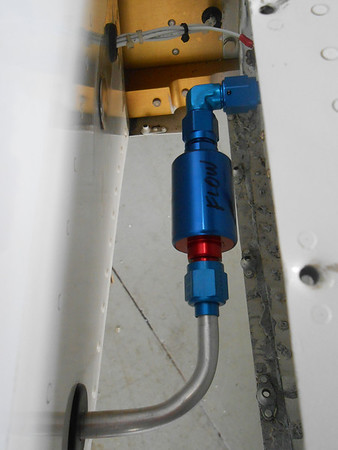Old 07-29-2013, 01:31 PM
Don at Airflow Don at Airflow is offline
Join Date: Jun 2006
Posts: 216
Default Gascolator
This is a letter we wrote to a customer about gascolator use in fuel injected engines.
To fully understand the situation you must first understand why a gascolator was used in the first place. Back when carburetors were the only source of fuel metering on aircraft, water was a detriment to the operation of the engine. Of course water won’t burn but the main reason was that water being heaver than fuel would sink to the bottom of the float bowl. Water also has a higher surface tension than fuel. Since the main jets are located in the bottom of the float bowl and the metering head (the suction created by the venturi to suck the fuel out of the bowl) is low on a carburetor, the water can actually block the flow of fuel through the main jets due to surface tension, thus starving the engine of fuel.
Enter the fuel injection system. There’s no float bowl, the fuel is under pressure (20-30 PSI). So in this case even if there’s some water in the system the fuel control will flow the liquid what ever it is. Granted the engine cannot burn water but there will be no interruption of the delivery of fuel to the engine.
One thing that is in the carburetors favor is that with the float bowl, if any foamy fuel or fuel vapor is in the system, the float bowl will vent off the vapor and the main jets are only exposed to liquid fuel. Correct fuel metering in this case is mostly not effected. Unless the engine driven fuel pump or boost pump is vapor locked the engine will get fuel. In this respect, carburetors are less affected by hot operation. More on that subject later.
Now look at the aircraft fuel system. In an RV aircraft the fuel tanks are the lowest point in the fuel system. Water will be in the sumps of the tanks. If water is found during a sumping operation then further investigation should be made concerning the entire aircraft fuel system condition.
1. Installing a gascolator in any other place other than the wing roots would result in the gascolator being higher than the lowest point in the fuel system. Not the place to catch water.
2. Since the RV aircraft can do some aerobatic maneuvers, rolling the aircraft upside down would dump any water into the fuel system if any were held in the gascolator.
3. Since the fuel injection system does not have a float bowl, fuel vapor is a problem and can cause poor fuel metering. Avgas boils at around 130 degrees F at sea level. The boiling point gets lower as altitude increases and also with a decrease in fuel pressure on the suction side of the fuel pump (flow losses in the fuel system). Since the gascolator is typically installed on the firewall, it is subject to a high heat environment. The volume of fuel in the gascolator does not change very fast at low power therefore the fuel in the gascolator picks up heat, which can lead to fuel vapor issues and possible vapor lock of the engine driven fuel pump.
4. Installation of the gascolator on the fire wall though not recommended on this installation can be accomplished by the following:
a. Make sure the gascolator can withstand 30 PSI, as it will be pressurized when the boost pump is on.
b. Install a blast shield over the gascolator and provide blast air to keep the gascolator cool.
c. Understand that having a volume of fuel on the firewall (gascolator) may result in rough engine operation and poor idle, under hot conditions.
d. With fuel injected installations we want to minimize the volume of fuel in the engine compartment as much as possible. This applies to hose routing and components that increase the volume of fuel that can be heated.
Hope this helps
Don





